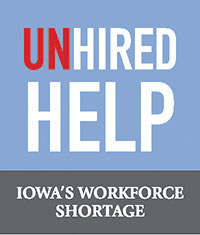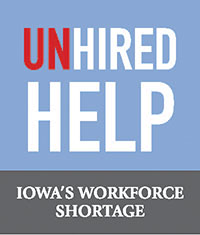
In the second part of this new six-part, members-only series on Iowa’s workforce shortage, the CBJ explores the wants and needs of employers in trying to hire workers. Read the first installment at bit.ly/unhiredhelp.
By Katharine Carlon
[email protected]
 When Corridor economic development groups released their 2018 existing industry surveys last month, the message was consistent — and bleak.
When Corridor economic development groups released their 2018 existing industry surveys last month, the message was consistent — and bleak.
Companies are “stifled” from further growth until they can attract and retain more workers, said Iowa City Area Development Group President Mark Nolte in a video presentation, lamenting that while Johnson County is the second-fastest growing area in the state, new jobs greatly outpaced labor force growth. That trend is expected to continue, all with the specter of sub-2 percent unemployment hovering in the air.
Corridor-wide, the Cedar Rapids Metro Economic Alliance reported 82 percent of employers experienced recruitment problems in 2018, with workforce availability rated at a near-record low 3.8 on a 7-point scale. Population growth is headed in the right direction, with data researcher Woods & Poole projecting a population increase of more than 6,900 people in the seven-county region through 2020. But, the report flatly states, that “doesn’t even replace retiring workers, much less close the gap on the need for workers.”
Empty desks, undriven trucks, stressed hospitals and unmanned factory floors tell the story of the region’s workplace woes, making it easy for employers to fall prey to a sort of “anyone will do” mentality, hiring the first person that’s available and more or less fits the requirements of a role.
The challenge, however, is far more complex than filling positions with warm bodies. The difficulty of finding workers is compounded by the need to find the right ones.
Kate Pine, business marketing specialist for IowaWORKS, pointed to the recent Workforce Needs Assessment survey conducted by Iowa Workforce Development, indicating “applicants are lacking in both soft or interpersonal skills … as well as the hard or occupational skills for the job.”
Singling out responses from Corridor employers, the survey suggested employers are frustrated. They reported that nearly a third of the labor pool lacks in critical and analytical thinking skills, and nearly 20 percent lack business communication skills.
The skills gap is even greater on the soft skills side, with 48.8 percent of employers reporting applicants coming up short in terms of motivation, 44.6 percent for dependability and 34.5 percent for time management.
“We have struggled really to find great employees,” said John Reinken, vice president of Eastern Iowa Blinds, which operates Budget Blinds franchises from its office in Lisbon, in a refrain heard across the region. Mr. Reinken admits that thanks to a strong benefits package, “Our best luck has come from taking employees from other people.”
Growing the region’s labor force is just part of the solution. To build the workforce to meet their needs today — and take them into the future — employers and employment experts are beginning to look beyond simply ticking boxes in terms of education and experience. They’re focusing on the skills that will be needed in a rapidly shifting technological landscape — one in which AI, robotics and automation are expected to displace millions of jobs worldwide over the next five years — and honing in on soft skills like creativity and problem-solving that will be key to navigating that change.
Employers today are putting nearly as much emphasis on whether new hires fit into their existing company culture as on skills and experience. And they’re balancing that with more diverse workplaces to drive innovation and creative solutions.
Read the full, members-only feature in the March 11 print or digital editions of the CBJ. Not a member? Join today.




